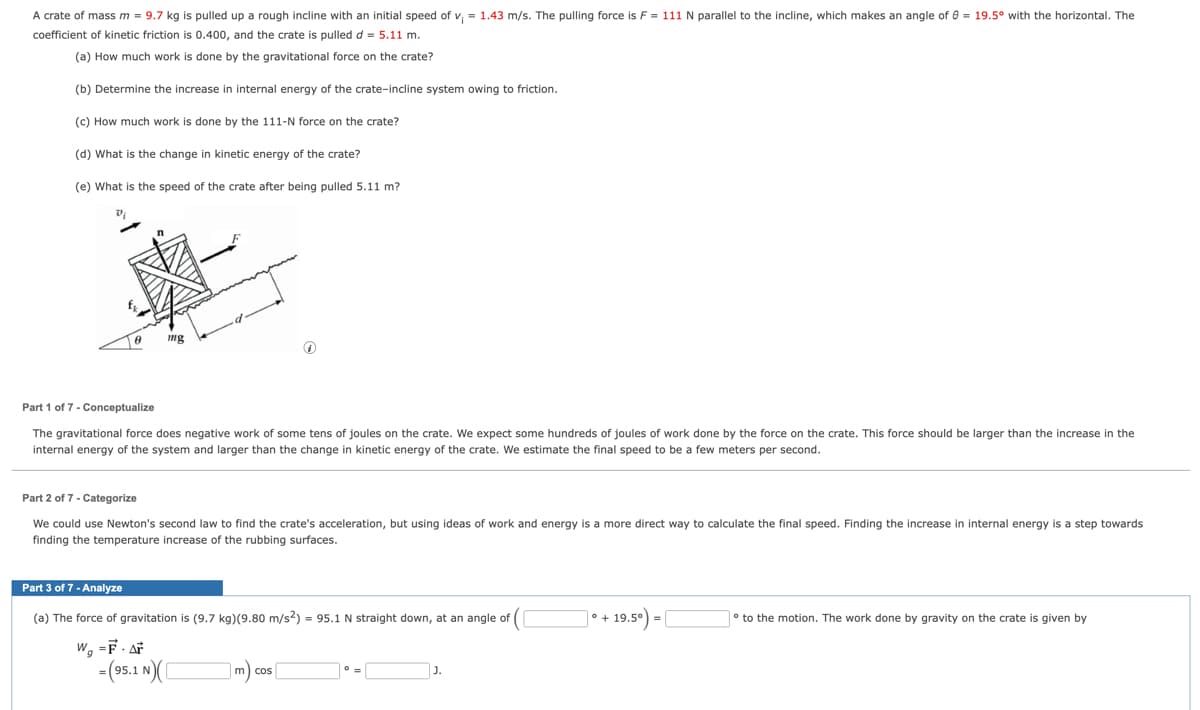A crate of mass m = 9.7 kg is pulled up a rough incline with an initial speed of v; = 1.43 m/s. The pulling force is F = 111 N parallel to the incline, which makes an angle of = 19.5° with the horizontal. The coefficient of kinetic friction is 0.400, and the crate is pulled d = 5.11 m. (a) How much work is done by the gravitational force on the crate? (b) Determine the increase in internal energy of the crate-incline system owing to friction. (c) How much work is done by the 111-N force on the crate? (d) What is the change in kinetic energy of the crate? (e) What is the speed of the crate after being pulled 5.11 m?
A crate of mass m = 9.7 kg is pulled up a rough incline with an initial speed of v; = 1.43 m/s. The pulling force is F = 111 N parallel to the incline, which makes an angle of = 19.5° with the horizontal. The coefficient of kinetic friction is 0.400, and the crate is pulled d = 5.11 m. (a) How much work is done by the gravitational force on the crate? (b) Determine the increase in internal energy of the crate-incline system owing to friction. (c) How much work is done by the 111-N force on the crate? (d) What is the change in kinetic energy of the crate? (e) What is the speed of the crate after being pulled 5.11 m?
University Physics Volume 1
18th Edition
ISBN:9781938168277
Author:William Moebs, Samuel J. Ling, Jeff Sanny
Publisher:William Moebs, Samuel J. Ling, Jeff Sanny
Chapter8: Potential Energy And Conservation Of Energy
Section: Chapter Questions
Problem 81AP: Repeat the preceding problem, but this time, suppose that the work done by air resistance cannot be...
Related questions
Topic Video
Question
100%
need help with last part only solve for (a) the force of gravitation is full part.

Transcribed Image Text:A crate of mass m = 9.7 kg is pulled up a rough incline with an initial speed of v; = 1.43 m/s. The pulling force is F = 111 N parallel to the incline, which makes an angle of = 19.5° with the horizontal. The
coefficient of kinetic friction is 0.400, and the crate is pulled d = 5.11 m.
(a) How much work is done by the gravitational force on the crate?
(b) Determine the increase in internal energy of the crate-incline system owing to friction.
(c) How much work is done by the 111-N force on the crate?
(d) What is the change in kinetic energy of the crate?
(e) What is the speed of the crate after being pulled 5.11 m?
mg
Part 1 of 7 - Conceptualize
The gravitational force does negative work of some tens of joules on the crate. We expect some hundreds of joules of work done by the force on the crate. This force should be larger than the increase in the
internal energy of the system and larger than the change in kinetic energy of the crate. We estimate the final speed to be a few meters per second.
Part 2 of 7 - Categorize
We could use Newton's second law to find the crate's acceleration, but using ideas of work and energy is a more direct way to calculate the final speed. Finding the increase in internal energy is a step towards
finding the temperature increase of the rubbing surfaces.
Part 3 of 7 - Analyze
(a) The force of gravitation is (9.7 kg) (9.80 m/s²) = 95.1 N straight down, at an angle of
W₂ =F. AF
-(95.1 N
m cos
J.
° +
19.5°).
=
to the motion. The work done by gravity on the crate is given by

Transcribed Image Text:(a) The force of gravitation is (9.7 kg)(9.80 m/s²) = 95.1 N straight down, at an angle of
W₁ =F-AF
(95.1 N
m cos
J.
19.5°)
to the motion. The work done by gravity on the crate is given by
Expert Solution
This question has been solved!
Explore an expertly crafted, step-by-step solution for a thorough understanding of key concepts.
Step by step
Solved in 3 steps with 3 images

Knowledge Booster
Learn more about
Need a deep-dive on the concept behind this application? Look no further. Learn more about this topic, physics and related others by exploring similar questions and additional content below.Recommended textbooks for you

University Physics Volume 1
Physics
ISBN:
9781938168277
Author:
William Moebs, Samuel J. Ling, Jeff Sanny
Publisher:
OpenStax - Rice University

Physics for Scientists and Engineers, Technology …
Physics
ISBN:
9781305116399
Author:
Raymond A. Serway, John W. Jewett
Publisher:
Cengage Learning

Principles of Physics: A Calculus-Based Text
Physics
ISBN:
9781133104261
Author:
Raymond A. Serway, John W. Jewett
Publisher:
Cengage Learning

University Physics Volume 1
Physics
ISBN:
9781938168277
Author:
William Moebs, Samuel J. Ling, Jeff Sanny
Publisher:
OpenStax - Rice University

Physics for Scientists and Engineers, Technology …
Physics
ISBN:
9781305116399
Author:
Raymond A. Serway, John W. Jewett
Publisher:
Cengage Learning

Principles of Physics: A Calculus-Based Text
Physics
ISBN:
9781133104261
Author:
Raymond A. Serway, John W. Jewett
Publisher:
Cengage Learning

College Physics
Physics
ISBN:
9781285737027
Author:
Raymond A. Serway, Chris Vuille
Publisher:
Cengage Learning

College Physics
Physics
ISBN:
9781305952300
Author:
Raymond A. Serway, Chris Vuille
Publisher:
Cengage Learning

Physics for Scientists and Engineers: Foundations…
Physics
ISBN:
9781133939146
Author:
Katz, Debora M.
Publisher:
Cengage Learning